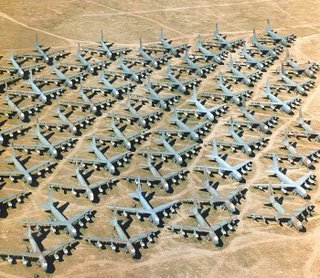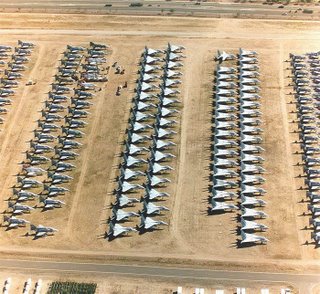 I was thinking of a tribute to our vets this week. I just wanted something with a little different emphasis on the service these men and women have made.
I was thinking of a tribute to our vets this week. I just wanted something with a little different emphasis on the service these men and women have made.To the rescue.
A friend of mine, Al Hammel, sent me some pics of this, the Davis-Monthan AFB, Aerospace Maintenance and Regeneration Center (AKA the USAF Bone Yard) located in Tucson, AZ. Additional views are , here, and here. Kodak has put together a very interesting tour of the facility here. These aircraft were serviced and flown by our vets.
They provided food and ammunition to our fighting troops.
They flew the wounded to hospitals.
They dropped thousands and thousands of tons of bombs.
They strafed enemy positions and blew up tanks.
They destroyed radar facilities.
They interdicted the resupply of opposing forces.
And a lot more...
Total American Air Force aircraft losses during World War II:
27,694 aircraft, including 8,314 heavy bombers, 1,623 medium and light bombers,Out of 135,00 men assigned to the 8th Army Air Force, 30,000 men lost their lives in combat.
and 8,481 fighters as destroyed in combat.
 Flying is a dangerous business. Just in training missions during WWII there were 6,351 fatal accidents with over 15,500 fatalities and the loss of over 7,100 aircraft.
Flying is a dangerous business. Just in training missions during WWII there were 6,351 fatal accidents with over 15,500 fatalities and the loss of over 7,100 aircraft.These aircraft are a lot like our vets. They don't complain and they still serve as best as they can. Like the men who flew them, these craft are a credit to our nation.
This is the only AFB facility that makes a profit.
Davis-Monthan is where military aircraft are stripped down and prepared for storage in the hot, dry desert climate. With over 1,600 aircraft, the USAF Bone Yard is is the third largest air force in the world. Most of the aircraft that come into the Aerospace Maintenance and Regeneration Center are flown in under their own power. Some are refitted and readied for sale to other nations. Others, such as B-52's, are stripped of vital parts and used to keep their brothers alive and flying. Some planes are reassembled for use as target practise or in movies.
 America built approximately 300,000 aircraft during WWI, most of them for the armed services. Approximately one half of them lasted through hostilities and downsizing and became surplus. Some of the aircraft stationed overseas were destroyed or off loaded out in the middle of the ocean. Some aircraft were sold; after the war you could buy a BT-13 combat trainer for $450 or a B-32 bomber for $32,500.
America built approximately 300,000 aircraft during WWI, most of them for the armed services. Approximately one half of them lasted through hostilities and downsizing and became surplus. Some of the aircraft stationed overseas were destroyed or off loaded out in the middle of the ocean. Some aircraft were sold; after the war you could buy a BT-13 combat trainer for $450 or a B-32 bomber for $32,500.After WWII, the US had several facilities where surplus aircraft were stored and/or scrapped. Hundreds of millions of pounds of aircraft aluminum were recovered in this fashion.
By 1959, Davis-Monthan alone had 4,000 aircraft. In 1965 it was chosen as the single, primary facility for storage of all USAF surplus planes.
No comments:
Post a Comment